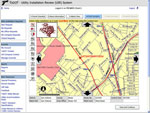Researchers test and implement online system for right-of-way (ROW) utility permits
 Try to think of an aspect of our lives that is not impacted by the Internet. The technology that brought us video on demand and faster-than-you-can-blink searches now offers an online system to benefit utility companies and transportation agencies.
Try to think of an aspect of our lives that is not impacted by the Internet. The technology that brought us video on demand and faster-than-you-can-blink searches now offers an online system to benefit utility companies and transportation agencies.
Researchers at the Texas Transportation Institute (TTI) are in the process of testing and implementing an online system designed to take right-of-way (ROW) utility permitting into the digital world forever. The implementation project is sponsored by the Texas Department of Transportation (TxDOT) and is being led at TTI by Associate Research Engineer Cesar Quiroga.

The history of the research begins with John Campbell, director of TxDOT’s ROW Division, who had an idea in the late 1990s to develop a comprehensive inventory of utilities within the Department’s ROW. Research conducted at TTI resulted in a prototype geographic information system (GIS)-based model to track utility inventories and a web-based prototype to automate the utility permitting process. That research received a TxDOT Top Innovation award in 2002.
TxDOT decided to implement the findings of the research through two implementation projects, one of which focused on the online utility permitting process. Quiroga’s team took the research a significant step further by creating the Utility Installation Review (UIR) online system. UIR automates and standardizes the submission, review, approval, inspection and archival of utility permit applications. The system enables the online submission of utility permit applications, including:
- uploading of engineering drawings and other supporting documentation;
- converting uploaded documents into PDF files;
- a GIS-based visualization, or map, of utility permit locations;
- a system to track permits through the approval process;
- e-mail notification; and
- reporting capabilities.

“We started testing the online utility permitting system in San Antonio in 2005,” says Quiroga. “The District used the system for a few months in parallel to the old paper system. After the San Antonio District went online with their permitting efforts, we collaborated with the Pharr District to test and implement the system there. Then we moved on to assist the Bryan District.”
TxDOT and utility companies benefit from the use of the online utility permitting process. “TxDOT reviews many thousands of utility permit applications per year,” says Quiroga. “They receive a large number of application packages in the mail, which may or may not contain everything necessary to review and approve the permit. The benefits of using an online system include preservation of institutional memory at TxDOT, improvements in the quality of the information provided and document retention.”
- Preserving institutional memory—as TxDOT employees move on or retire, they take with them valuable institutional memory about utility locations in the ROW. The online system relies on locational attributes and an interactive GIS-based online map that helps preserve this vital information.
- Quality of information—the online system improves the quality of information gathered by providing utility company applicants with a user-friendly interface that includes checklists and other quality controls. Online access to all permit documentation also helps improve the quality of the approval process, enabling a more thorough review of the documentation as well as expedited permitting.
- Document retention—whereas paper permit applications can be misplaced or even discarded after a few years, the online system retains permit applications and records indefinitely.

“Instead of having to mail a permit application, which includes an original and several copies of the application form and attachments, all utility company representatives have to do now is log in, complete the steps, hit a button to submit and it’s done,” says Quiroga. “On the TxDOT side, instead of reviewing, forwarding and archiving paper copies, officials just open a permit application, review the documentation and event history and electronically route the application to the next person.”
Quiroga says that TxDOT plans to implement UIR statewide. The Fort Worth and Houston Districts will soon join the San Antonio, Pharr and Bryan Districts in using the system. Other departments of transportation around the country have expressed an interest in the system, as well.
